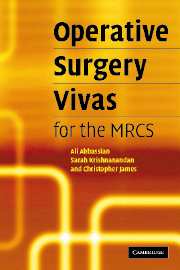Book contents
- Frontmatter
- Contents
- Preface
- 1 The elective repair of an abdominal aortic aneurysm
- 2 Adrenalectomy
- 3 Amputation (below knee)
- 4 Anorectal abscesses, fistulae and pilonidal sinus
- 5 Appendicectomy
- 6 Principles of bowel anastomosis
- 7 Breast surgery
- 8 Carotid endarterectomy
- 9 Carpal tunnel decompression
- 10 Central venous cannulation
- 11 Cholecystectomy (laparoscopic)
- 12 Circumcision
- 13 Colles' fracture (closed reduction of)
- 14 Compound fractures
- 15 Dupuytren's contracture release
- 16 Dynamic hip screw
- 17 Fasciotomy for compartment syndrome
- 18 Femoral embolectomy
- 19 Femoral hernia repair
- 20 Haemorrhoidectomy
- 21 Hip surgery
- 22 Hydrocele repair
- 23 The open repair of an inguinal hernia
- 24 Laparotomy and abdominal incisions
- 25 Oesophago-gastroduodenoscopy
- 26 Orchidectomy
- 27 Parotidectomy
- 28 Perforated peptic ulcer
- 29 Pyloric stenosis and Ramstedt's pyloromyotomy
- 30 Right hemicolectomy
- 31 Skin cover (the reconstructive ladder)
- 32 Spinal procedures
- 33 Splenectomy
- 34 Stomas
- 35 Submandibular gland excision
- 36 Tendon repairs
- 37 Thoracostomy (insertion of a chest drain)
- 38 Thoracotomy
- 39 Thyroidectomy
- 40 Tracheostomy
- 41 Urinary retention and related surgical procedures
- 42 Varicose vein surgery
- 43 Vasectomy
- 44 Zadik's procedure
26 - Orchidectomy
Published online by Cambridge University Press: 16 October 2009
- Frontmatter
- Contents
- Preface
- 1 The elective repair of an abdominal aortic aneurysm
- 2 Adrenalectomy
- 3 Amputation (below knee)
- 4 Anorectal abscesses, fistulae and pilonidal sinus
- 5 Appendicectomy
- 6 Principles of bowel anastomosis
- 7 Breast surgery
- 8 Carotid endarterectomy
- 9 Carpal tunnel decompression
- 10 Central venous cannulation
- 11 Cholecystectomy (laparoscopic)
- 12 Circumcision
- 13 Colles' fracture (closed reduction of)
- 14 Compound fractures
- 15 Dupuytren's contracture release
- 16 Dynamic hip screw
- 17 Fasciotomy for compartment syndrome
- 18 Femoral embolectomy
- 19 Femoral hernia repair
- 20 Haemorrhoidectomy
- 21 Hip surgery
- 22 Hydrocele repair
- 23 The open repair of an inguinal hernia
- 24 Laparotomy and abdominal incisions
- 25 Oesophago-gastroduodenoscopy
- 26 Orchidectomy
- 27 Parotidectomy
- 28 Perforated peptic ulcer
- 29 Pyloric stenosis and Ramstedt's pyloromyotomy
- 30 Right hemicolectomy
- 31 Skin cover (the reconstructive ladder)
- 32 Spinal procedures
- 33 Splenectomy
- 34 Stomas
- 35 Submandibular gland excision
- 36 Tendon repairs
- 37 Thoracostomy (insertion of a chest drain)
- 38 Thoracotomy
- 39 Thyroidectomy
- 40 Tracheostomy
- 41 Urinary retention and related surgical procedures
- 42 Varicose vein surgery
- 43 Vasectomy
- 44 Zadik's procedure
Summary
What two approaches do you know for performing an orchidectomy?
The two approaches for performing an orchidectomy are the scrotal or inguinal approaches.
Where do the lymphatics of the testis and the scrotal skin drain to respectively?
The testis drains to the para-aortic lymph nodes at the level of L2.
The scrotal skin drains via both the internal and external pudendal systems to the deep and superficial inguinal lymph nodes.
How does the above knowledge dictate the approach for orchidectomy for a testicular tumour?
As the scrotal skin and the testis have different blood supply and lymph drainage, an orchidectomy for a testicular tumour should be performed via an inguinal approach to avoid the possibility of tumour seeding to the deep and superficial inguinal systems.
What pre-operative measures must be taken prior to an orchidectomy?
Informed consent (consider sperm banking)
Clinical examination: tumour, other testis, hepatomegaly, lungs
Tumour markers, liver and bone profile
Chest X-ray (CXR)
Scrotal ultrasound examining both testes
Chest and abdominal CT scan (lungs, liver and para-aortic lymph nodes)
Isotope bone scan
Briefly describe how you would perform an orchidectomy for testicular tumour
Position The patient is placed under a general anaesthetic and supine on the table. A routine preparation and draping of the groin is performed.
Incision and procedure A groin crease incision is made and is deepened into the inguinal canal by incising the external oblique aponeurosis (superficial inguinal ring). The spermatic cord is then identified and cross-clamped.
- Type
- Chapter
- Information
- Operative Surgery Vivas for the MRCS , pp. 97 - 100Publisher: Cambridge University PressPrint publication year: 2006

